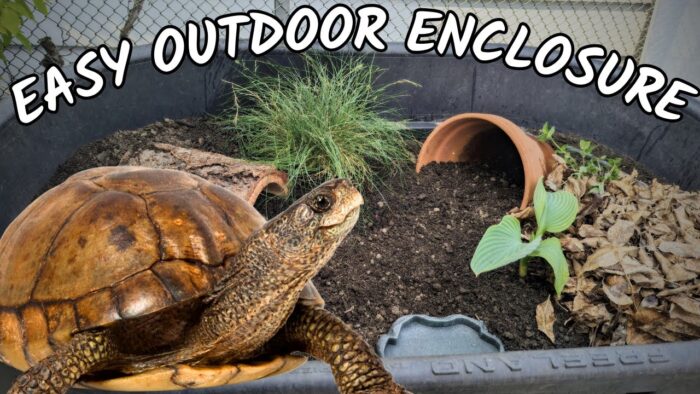If you want to let your pet turtles enjoy some time outdoors, setting up a proper enclosure is crucial for keeping them healthy and secure. Turtles require specific care when being housed outside, as they can easily overheat or get dehydrated. Their outdoor habitat also needs ample space as well as features that allow them to exhibit their natural behaviors. In this article we talk about How to Set Up a Safe Outdoor Enclosure for Turtles.
Follow this comprehensive guide to learn everything about How to Set Up a Safe Outdoor Enclosure for Turtles. We’ll cover suitable materials, ideal placement, proper dimensions, necessities like shelters, plants and accessories, and tips for maintaining safety and cleanliness. With the right setup, your turtles can thrive when spending time outdoors.
Choosing a Suitable Location
When deciding where to build your outdoor turtle habitat, consider these factors:
- Sun Exposure: Turtles need areas of both sun and shade. Avoid excessively shady or bright spots. Areas with a few hours of gentle sunlight are best.
- Accessibility: Pick a spot that’s easy for you to access frequently for cleaning, feeding and monitoring the turtles.
- Security: Don’t place the enclosure anywhere the turtles can be disturbed or stolen. Keep them safe from other pets, wildlife and people.
- Ground Surface: Install the enclosure on a flat, level surface with good drainage to prevent flooding. Grass or dirt works better than concrete.
- Nearby Hazards: Keep the area free of toxic plants, lawn treatments, pools and other dangers. Check for sharp objects, debris or gaps where turtles could get stuck or escape.
Choose an area that meets all these safety criteria before building your outdoor turtle habitat there.
Structural Materials
For containing your aquatic turtles outside, use materials that are safe, durable and appropriate for the local climate. Good options include:
- Coated Wire Mesh: Galvanized after welding wire mesh coated in vinyl or plastic is ideal. It won’t rust, resists chewing, and provides adequate ventilation.
- Wood: Use rot-resistant cedar, redwood or pine. Avoid treated lumber, as it can leach chemicals. Seal any indoor wood before installing outside.
- Plastic Lattice: White vinyl lattice fencing material works well. It lasts outdoors and allows airflow.
- Bricks/Concrete Blocks: For a more permanent enclosure with solid walls, construct with herp-safe sealants.
The fencing should be at least 2 feet high around the entire perimeter to prevent escapes. The framework also needs a secure top or roof made of wire or wood. The cover prevents other animals and birds of prey from disturbing your turtles.
Ideal Size and Layout
When planning your outdoor turtle habitat’s dimensions and features, bigger is always better. The more ample space they have, the better they’ll thrive.
Here are some size and layout recommendations:
- Minimum Size: No smaller than 6 by 8 feet (length by width). Larger growing turtle species need bigger.
- Space Per Turtle: Provide at least 10 square feet per smaller turtle, and 15+ square feet per bigger turtle.
- Depth: The pond or wet area should be at least 1.5 to 2 feet deep, with a shallow end for easy climbing in and out.
- Basking Area: Include a dry elevated basking platform or sloping land area for turtles to completely exit the water.
- Hiding Places: Have at least one hide or shelter per turtle so they can retreat and feel secure.
Make sure to position all the components – water area, basking zone, shelters, plants, etc. – in a manner ideal for turtle safety and comfort based on their natural behaviors and needs.
Adding Water
The water element is vital for keeping aquatic turtles healthy outdoors. Here’s how to add it properly:
- Pond Liner: Line the ground with non-toxic, UV-resistant pond liner rated for outdoor use to hold water.
- Pool: You can also use a plastic turtle pool or stock tank. These are easy to set up but provide less walking space than a pond.
- Water Type: Fill with dechlorinated water. Use a water conditioner to remove chemicals.
- Changing Water: Drain and refresh part of the water at least once or twice a week to keep it clean.
- Filter: Install a quality pond filter and pump suited to the water volume to filter waste and prevent disease.
The water should be fresh, oxygenated, adequately filtered and regularly cleaned. Also provide a water heater maintained at 75-80°F for cooler climates.
Essential Accessories
Outfit your outdoor turtle enclosure with these necessary components for safety and enrichment:
- Substrate: Use smooth river rocks or soft sand on land areas. Avoid loose particles that could be ingested.
- Plants: Add sturdy aquatic plants like water lilies or hyacinth for shelter and ambience. Spider plants and pothos work well for landscaping.
- Basking Lights: Install UVB and heat lamps over the dry basking zone to help them properly regulate body temperature.
- Food Bowls: Shallow, stable bowls for offering food in the water so it doesn’t foul the habitat.
- Calcium Block: Supply calcium supplements for shell health.
- Thermometers: Place waterproof thermometers in land and water areas to monitor temperatures.
Make adjustments as needed to maintain the ideal temperature gradient and habitat quality.
Safety and Maintenance Musts
Caring for pet turtles in an outdoor enclosure involves some key safety practices, including:
- Predator Protection: Use electric fencing, mesh lids, cinder blocks or other barriers to prevent predators like raccoons from disturbing your turtles.
- Locks: Secure doors, lids and gates with child-proof locks so unauthorized people or curious kids can’t access the turtles.
- Night Housing: Bring smaller turtles indoors overnight or install a protected, insulated turtle house for larger species to stay safe from temperature extremes.
You’ll also need to clean the habitat at least twice a week – daily is better. Remove waste, change water, wash items in mild soap and immediately secure everything so turtles don’t escape.
Properly designed and cared for, an outdoor turtle habitat lets your pets thrive with enrichment and exercise. Just be sure to meet all their complex needs for optimum health and happiness outside. With the right enclosure setup and precautions, you can give your turtles a little taste of the wild safely in your own backyard. I sincerely hope you find this “How to Set Up a Safe Outdoor Enclosure for Turtles” article helpful.

Dr. Hansika Singh is a skilled veterinarian with a Doctorate in Veterinary Medicine and over six years of hands-on experience in the field. Her expertise in pet health is complemented by a holistic approach that prioritizes both physical and emotional well-being. Dr. Singh is committed to providing high-quality care and practical advice to ensure pets lead healthy, happy lives.
As the leading expert on everythingpetstuff.com, Dr. Singh shares her extensive knowledge and insights through this platform and her popular social media channels. Follow her for valuable tips and advice on pet care: Instagram, YouTube, and Facebook.

